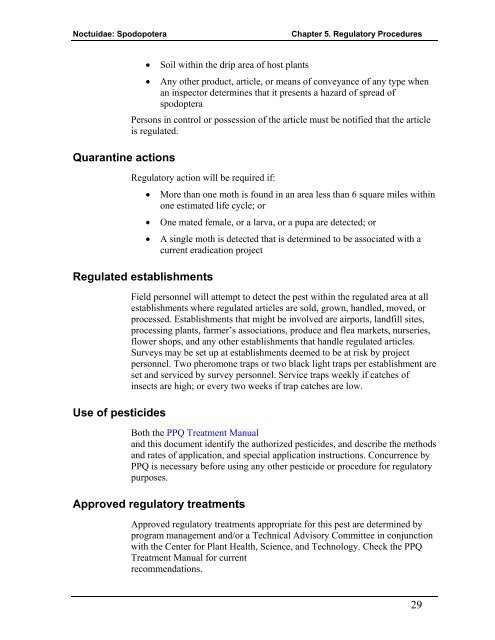New Pest Response Guidelines - Phytosanitary Resources
New Pest Response Guidelines - Phytosanitary Resources
New Pest Response Guidelines - Phytosanitary Resources
Create successful ePaper yourself
Turn your PDF publications into a flip-book with our unique Google optimized e-Paper software.
Noctuidae: Spodopotera<br />
Chapter 5. Regulatory Procedures<br />
Quarantine actions<br />
• Soil within the drip area of host plants<br />
• Any other product, article, or means of conveyance of any type when<br />
an inspector determines that it presents a hazard of spread of<br />
spodoptera<br />
Persons in control or possession of the article must be notified that the article<br />
is regulated.<br />
Regulatory action will be required if:<br />
Regulated establishments<br />
Use of pesticides<br />
• More than one moth is found in an area less than 6 square miles within<br />
one estimated life cycle; or<br />
• One mated female, or a larva, or a pupa are detected; or<br />
• A single moth is detected that is determined to be associated with a<br />
current eradication project<br />
Field personnel will attempt to detect the pest within the regulated area at all<br />
establishments where regulated articles are sold, grown, handled, moved, or<br />
processed. Establishments that might be involved are airports, landfill sites,<br />
processing plants, farmer’s associations, produce and flea markets, nurseries,<br />
flower shops, and any other establishments that handle regulated articles.<br />
Surveys may be set up at establishments deemed to be at risk by project<br />
personnel. Two pheromone traps or two black light traps per establishment are<br />
set and serviced by survey personnel. Service traps weekly if catches of<br />
insects are high; or every two weeks if trap catches are low.<br />
Both the PPQ Treatment Manual<br />
and this document identify the authorized pesticides, and describe the methods<br />
and rates of application, and special application instructions. Concurrence by<br />
PPQ is necessary before using any other pesticide or procedure for regulatory<br />
purposes.<br />
Approved regulatory treatments<br />
Approved regulatory treatments appropriate for this pest are determined by<br />
program management and/or a Technical Advisory Committee in conjunction<br />
with the Center for Plant Health, Science, and Technology. Check the PPQ<br />
Treatment Manual for current<br />
recommendations.<br />
29













